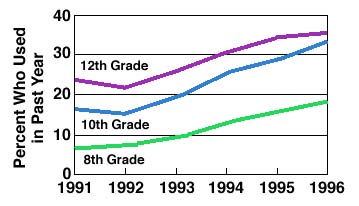The rise in marijuana and tobacco use that began in the early 1990s among America's young people continued last year, according to NIDA's 1996 Monitoring the Future study. The study found that 8th and 10th grade students increased their use of marijuana and tobacco in 1996, while 12th graders continued to use these two substances at generally the same level as they did in 1995. Students' use of other illicit drugs presented a mixed but overall unchanged pattern in 1996, the study indicated.
"The survey tells us that drug use among young people is at unacceptably high levels, that the core of the problem is marijuana, and that we must fight aggressively to change these trends," Health and Human Services Secretary Dr. Donna E. Shalala said at a press conference held in Washington,D.C., last December to announce the study's results. "The survey shows that our marijuana problem is fueled by teens who believe that marijuana is not harmful," Secretary Shalala said. The perceived risk of harm from using marijuana continued to decline among 8th and 10th graders in 1996, while perceived risk of harm from using other drugs either increased or remained level among these students, according to the study.
 Trends in Adolescents' Annual Use of Marijuana. Students in the 8th and 10th grades increased their use of marijuana in 1996, while 12th graders continued to use marijuana at generally the same level as they did in 1995. As this graph shows, past-year marijuana use has been increasing among all grade levels since 1992.
Trends in Adolescents' Annual Use of Marijuana. Students in the 8th and 10th grades increased their use of marijuana in 1996, while 12th graders continued to use marijuana at generally the same level as they did in 1995. As this graph shows, past-year marijuana use has been increasing among all grade levels since 1992."It is important that young people understand the harm and danger caused by illicit drug use," NIDA Director Dr. Alan I. Leshner said. "Years of scientific research have made this risk ever clearer, not just for drugs such as cocaine and heroin but also for marijuana,"he stressed. Clinical studies have shown that marijuana can have a host of acute and short-term effects including impairment of skills related to attention, memory, and learning as well as complex motor skills such as those needed to drive a car. Clinical studies also indicate that regular marijuana users may have many of the same respiratory problems that cigarette smokers have. Animal studies suggest that chronic marijuana use can affect the brain and immune system, but clinical studies are needed to verify these effects in humans.
The 1996 Monitoring the Future study showed increases in lifetime, annual, current, and daily use of marijuana for 8th and 10th graders from 1995 to 1996. Current marijuana use, which is use within the past 30 days, went from 9.1 percent to 11.3 percent among 8th graders and from 17.2 percent to 20.4 percent among 10th graders. Current marijuana use has increased more than 250 percent among 8th graders since 1991 and more than 150 percent for 10th graders since 1992.
For the first time since 1993, annual, current, and daily use of marijuana by high school seniors showed no significant changes. However, the percentage of high school seniors who had used marijuana at least once in their lifetimes increased from 41.7 percent in 1995 to 44.9 percent in 1996. In addition, 4.9 percent of seniors reported smoking marijuana every day, a statistically nonsignificant rise from 4.6 percent in 1995, but more than double the 2.0 percent of seniors who used marijuana daily in 1991.
Cigarette use has increased among students in all three grade levels since 1991, according to the study. Between 1995 and 1996, 8th graders' current use of cigarettes increased from 19.1 percent to 21.0 percent. Among 10th graders, current use of cigarettes increased from 27.9 percent to 30.4 percent. Current smoking rates among 12th graders remained statistically unchanged, rising 0.5 of a percentage point from 33.5 percent in 1995 to 34.0 percent in 1996. From 1991 to 1996, current use of cigarettes increased by nearly one-half among 8th and 10th graders and by nearly one-fifth among 12th graders, noted Dr. Lloyd Johnston from the University of Michigan, who conducted the study. These rates of cigarette smoking are "impressively high, especially compared to the 25 percent of all adults classified as current smokers," Dr. Johnston said.
Young people's use of drugs other than marijuana and tobacco presented a mixed pattern in 1996:
- The percentage of 8th graders who reported having "been drunk" in the past month increased from 8.3 percent in 1995 to 9.6 percent in 1996. The percentage of 10th and 12th graders who said they had been drunk in the past month remained at high, though statistically unchanged, levels. In 1996, 21.3 percent of 10th graders and 31.3 percent of 12th graders reported having been drunk in the past month.
- Current use of all hallucinogens decreased among 12th graders from 4.4 percent in 1995 to 3.5 percent in 1996. Current use of LSD, a major component of the hallucinogen category, dropped among 12th graders from 4.0 percent to 2.5 percent, and among 10th graders, from 3.0 percent to 2.4 percent. Eighth graders' use of LSD remained unchanged.
- Seniors' current use of inhalants declined from 3.2 percent in 1995 to 2.5 percent in 1996. Use of inhalants by 8th and 10th graders remained unchanged.
